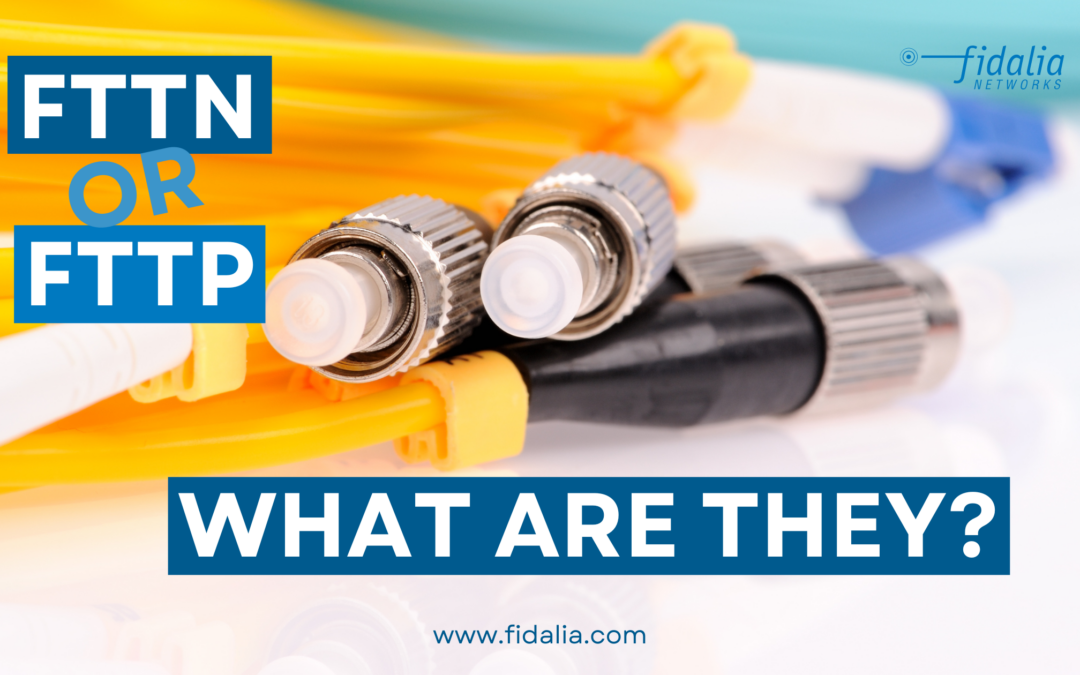The CRTC recently mandated the incumbent carriers offer FTTN services to their wholesale customers. This step forward for the Canadian public means increased competition and lower prices for Fibre internet access services across the country.
In today’s fast-paced business world, choosing the right internet service is crucial for staying competitive. Fibre internet delivers high-speed connections essential for efficient operations. In this article, we explore the two popular types of fibre internet: Fibre-to-the-Node (FTTN) and Fibre-to-the-Premises (FTTP). While both technologies are capable of supporting most business needs, specific applications such as VoIP perform better with the lower latency provided by FTTP. For a deeper dive into fibre internet options, consider reading our article about GPON and DIA, which may give you more information to help you choosing the right fibre technology.
What is FTTN (Fibre-to-the-Node)?
FTTN involves fibre optic cables running to a local node (usually either a 14″x14″ square box in the ground, or a waist-high metal box on the side of the road), from which copper wires connect to multiple premises. Utilizing GPON technology, FTTN can achieve speeds up to 3 Gbps in some areas, making it a robust option for many businesses.
Pros:
- Capable of high speeds up to 3 Gbps with GPON technology.
- Lower initial setup costs due to use of existing copper lines.
- Faster installation times compared to FTTP.
Cons:
- Potential variability in speed and reliability due to copper wire use and shared middle-mile infrastructure.
- Higher maintenance costs over time compared to FTTP.
- Generally no Service-Level-Agreement (SLA) for service availability (uptime)
What is FTTP (Fibre-to-the-Premises)?
FTTP provides a direct fibre optic connection to your business, ensuring the highest speeds and reliability. This method involves running fibre all the way to individual premises, offering significant performance advantages, especially in applications requiring low latency, such as VoIP.
Benefits:
- Offers the highest available internet speeds, typically faster than FTTN.
- Lower latency, ideal for VoIP and other real-time applications.
- More reliable connection with less interference.
Cons:
- Usually much higher installation costs (and time, as some installations take ~4 months)
- Higher monthly costs (usually ranging from $400 to $800)
- Commonly on 3- or 5-year terms
VoIP Support and Fibre Technologies
VoIP (Voice over Internet Protocol) requires a stable and consistent internet connection to function optimally. FTTP’s lower latency and higher reliability make it superior for VoIP applications, providing clearer call quality and fewer disruptions.
Comparing FTTN and FTTP Speeds
While FTTN with GPON can provide sufficient speeds for most business applications, FTTP offers higher speeds and more consistent performance, which can be critical for data-intensive services and larger enterprises.
Cost Comparison: FTTN vs FTTP
Although FTTP might require a higher initial investment for installation, its long-term benefits such as lower operational disruptions and maintenance can, sometimes, outweigh the costs, especially for businesses that rely heavily on stable and high-speed internet. For most businesses, though, FTTN is the better bet for “ease on wallet”.
Fibre Internet Options for Companies
Choosing the right fibre internet solution depends on your business size, budget, and specific needs. Both FTTN and FTTP offer unique benefits that may suit different business scenarios. For businesses that rely on uptime, an SLA may mean a higher availability (think 99.99% availability in some cases), faster mean-time-to-repair, and financial implications for service disruptions. In those cases, FTTP is the better option. FTTN is often offered at best-effort – with a similar deployment and support structure as regular broadband (Coax or DSL).
FTTN and FTTP Installation Requirements
Installation of FTTP is more extensive than FTTN, requiring more planning and potentially more disruption. However, for some businesses, the long-term benefits of a stable and fast internet connection are often worth the initial hassle.
FTTN Broadband Capabilities
With the implementation of GPON, FTTN is typically sufficient for small to medium businesses with moderate to high internet usage, providing speeds that meet most business needs.
Table: FTTN vs FTTP Comparison
Feature | FTTN with GPON | FTTP |
|---|---|---|
| Speed | Up to 3 Gbps | Typically faster than FTTN |
| Cost | Lower upfront cost | Higher upfront cost |
| Installation | Quicker, uses existing infrastructure | Longer, requires new infrastructure |
| Best for | Most businesses needing high speeds | Businesses requiring ultra-high speeds and low latency |
Both FTTN and FTTP have their place in modern internet infrastructure. While FTTN might be an economical choice for many, FTTP offers unparalleled speed and reliability for those willing to invest in top-tier internet services. For tailored advice on what might best suit your business needs, contact us.
Around the world, Fibre options take on a variety of different names and delivery architectures. If we haven’t answered your question here about FTTN or FTTP, please visit this page here at Wikipedia, which will give you some more insight into the optical internet. Careful, it’s a lot to read!
